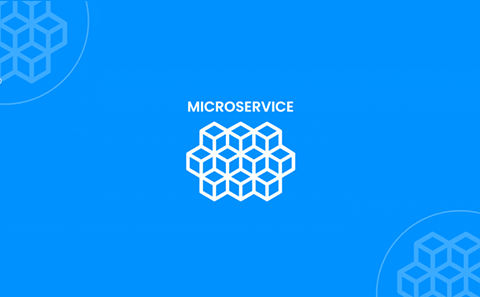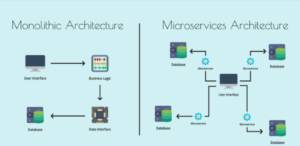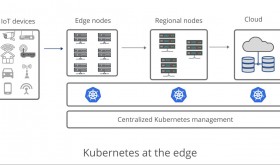
The microservices approach is often considered a technological breakthrough in the application development industry. It has transformed the ways developers deploy their applications. Unlike the conventional monolithic services, microservices have given a more independent, scalable and decentralized way of deploying applications. Modern-age application deployment has been characterized by the functional components of an entire application with the adoption of microservices in the process.
To reduce the process complexity, the concept of microservices was introduced. Microservices require developers to segregate the large codebase into parts on the basis of different functionalities.
The concept of microservices involves implementing a service-oriented code structure to deploy all application modules by putting in less time and effort. These microservices or micro-segments of the application code interact with each other through the database, storage, and/or APIs.
Evolution of Application Architecture With Microservices
Microservices are particularly recognized for transforming the accessibility of the application functionality for common users through their decentralized nature. The microservices architecture reduces the need for large-scale testing and maintenance of the application and saves the fundamental resources for service providers. Furthermore, it engages in advanced functional elements that feature;
Separate codebase, possibly in different languages/technologies for different application functionalities.
Personalized testing architecture for separate teams working on different parts of the applications.
Ease of application deployment for projects of all sizes ranging from small to medium to large-scale projects.

The fundamental idea of microservices was to reduce the efforts of developers by enabling parallel handling of broken-down segments of large applications. The utilization of concepts like continuous delivery in the process fastened it even further. Every microservice indulges in no reliance on other functionalities of the application.
Only relevant application components are affected when any changes in a specific application functionality are required. The general use cases of microservices comprise applications such as UI systems, data processing, and billing systems.
Important Roles of Microservices in Modern-Age Applications
With monolithic applications, a single element of the entire application architecture can hinder or terminate the process. This may cause significant loss to the organizations in terms of overall productivity, efficiency and growth of the businesses. If you consider an e-Commerce portal, there are several parallel processes going on such as product listing, placing orders, or checkouts. Large-scale utilization of the storage or CPU time by a single process can affect the overall output in monolithic applications. Thus, the advent of microservices in the app development market ushered in new advancements leading to hyper growth of the businesses.
Utilization of microservices not only helped in terms of productivity and revenues but also helped the end-users to engage in a rich user experience. It engaged in more simplistic methodologies to monitor different process segments of the operations executed through the complete applications.
The adoption of monolithic services has been reduced dramatically since the advent of microservices in developing applications. We shall discuss a few important roles played by microservices in modern-age application development;
Updation of Functionalities
Unlike monolithic app services, it is far easier to launch new functionalities by amending the codebase of particular microservices. This approach of amending the existing functionalities of an application does not make any impact on the complete deployment of the application. It reduces the possibility of errors, process failure, and indulges in an effective code development strategy for applications.
1. Rich Flexibility
Unlike monolithic services, microservices do not require large teams to handle the application. Small teams can work independently to perform parallel operations on microservices. Such an approach reduces the complexity in the application architecture with a systematic representation of communication between different nodes of the application.
2. High Scalability
Microservices architecture shows rich scalability as it can smartly handle small to large-scale projects. Unlike monolithic applications, microservices can scale the user traffic more interactively. This embarks the quality of service traffic handling within the application without affecting the entire application. It ultimately results in the fastened processing and stability of the application architecture on the server.
3. Easy Deployment & Service Incorporation
This is the most significant role played by microservices in modern-age application development. Unlike conventional development of monolithic apps, microservices indulge in smart easy deployment because of their distributed application entity for different functionalities. As mentioned earlier, only the relevant part of the application codebase or microservice is amended and redeployed without affecting the other microservices. It provides an independent approach of application deployment to the developers which is a transformative trend led by microservices.
4. Interactive Interface
Since all the services are provided to the clients independently to other microservices, it engages a fastened access to the required information or execution of the tasks. It engages in a dramatic decrease in the cognitive load for application users by reducing the service complexity and need to care about the internal architecture of the process. This approach helps developers to create an effective path of information conveyance for the users and manage large-scale applications easily.
5. Unprecedented Business Growth
By improving the ways of service delivery to the consumers, microservices has empowered small to large-scale companies and played a crucial role in their business growth. It has become relatively simpler for business organizations to introduce new processes and service campaigns using microservices that ultimately lead to lucrative business outcomes. Alongside this, microservices require teams that consist of comparatively fewer members. Experts suggest that microservices are the best for teams of reduced sizes.
6. Independent Use of Technologies
Developers following microservices architecture concepts for application development are not bound to use a particular set of tools and technologies. They can create applications using different technologies, programming languages, frameworks, or scripts that add flexibility to the process of app development.
All the above mentioned features were not quite available through the traditional development approach of monolithic architecture. Monolithic architectures were proven difficult to synchronize application compatibility with time.
Amazon Web Services (AWS) indulged in an application-oriented approach to execute its objectives. Its app mesh connected the most fundamental layer to detect microservices more interactively. Alongside, Google Cloud Platform (GCP) played a crucial role in contrasting embedded and hidden service mesh to a large-scale audience.
Wrapping Up
From continuous delivery to complete utilization of DevOps, microservices have a vital role to play in future-oriented app development services. Many might argue if automation is the future of technology, but it may necessarily have a crucial part in evolving Software development, deployment, and testing.
Software Industry leaders are considering microservices more than just a development trend. It is considered that microservices can evolve the future of app development to the next level. As per the users’ perspective, it may become the most sought way of developing applications with distributed functional components. It can help developers create large-scale and futuristic service applications that will utilize technology channels like automation to bring next-level customer experiences.
Hey, like this? Why not share it with a buddy?
Related Posts
Comments (3)
Comments are closed.










Pablo Villalpando
December 9, 2019SEO is always changing so leaving the strategy and tactics to Onum has more than paid for itself. We estimate ROI is over 10 to 1 – I can’t say enough about this team.
Pablo Villalpando
December 9, 2019Onum has been extremely consistent and reliable through our entire engagement. Our results speak for themselves.
Pablo Villalpando
December 9, 2019It also gives you insights on your market’s behavior such as location, times of activity, frequency of searches, technologies used, product preferences, etc.